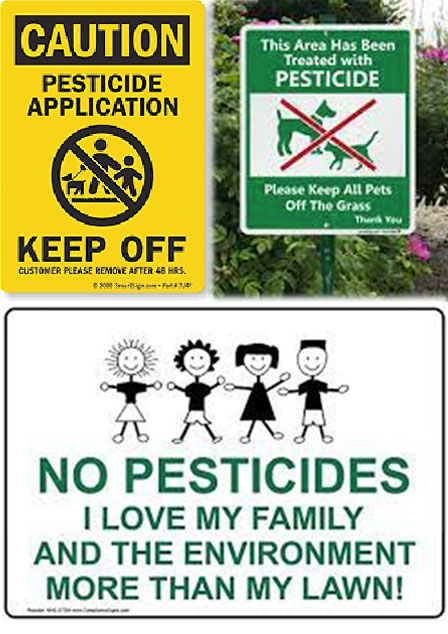
iStock
By Mary Carpenter
LIFESPANS increased by almost three years in U.S. cities after the 1997 Clean Air Act required reducing air pollution levels of fine particulate matter—known as PM2.5, referring to size of particles that form as an indirect result of automobile emissions. Spurring the changes was the Six Cities Study in the early 1990s, which found people dying earlier in the dirtiest cities (the worst was Steubenville, Ohio) and helped inspire the EPA’s Act.
The next target may be “landscape chemicals”—pesticides, herbicides and fertilizers disseminated by sprayers. The reason that yard signs—“CAUTION: Pesticide Application” and “NO PESTICIDES: I love My Family”—show images of adults as well as children with a thick red slash across them is to reflect increasing evidence of health risks that include neurodegenerative diseases, specifically ALS (amyotrophic lateral sclerosis).
On ever-changing lists of most dangerous commonly encountered chemicals, some start with glyphosate (in Roundup) and chlorpyrifos, along with a new class of landscape chemicals called neonics (neonicotinoids) that are sprayed on agricultural land, lawns and golf courses. Living or working near a golf course or agricultural area can increase the risk for an array of cancers, notably of the brain and colon. Said one Florida environmental consultant: “One of the most hazardous things you can do is live near a golf course.”

As worrisome chemicals become more difficult to keep track of, perhaps the most important question to ask is for proof that an individual has been harmed —although even this question comes with caveats. Issues like “data deficiency” can relate to the chemicals that become dangerous when they “bioaccumulate” over time, like flame retardants; or because of their interactions— such as when high levels of chlorine in tap water interact with other chemicals on the danger list (with abbreviated names such as THMM, bromos, dibros) even when those individual levels are not officially too high. (The defensive strategy of chemical companies focusing on lower risks of individual ingredients is the same delay tactic that was once used by Big Tobacco.)
The correlations of these chemicals to health effects might be sufficient warning when the current research has not yet established causation because waiting another 20 years to prove cause can be risky. A dramatic example used by environmentalists is Thalidomide, for which paying better attention to correlation might have avoided debilitating deformities in hundreds of children.
Phthalates, most recently in the news, top a different most dangerous list—along with PFAS and flame retardants —with findings of their presence in hamburgers and dozens of other foods at six popular chains, including McDonalds and Burger King. Familiar as ingredients in personal care products and beverage containers as “plasticizers” that make material more flexible, phthalates used in plastic gloves and food conveyor belts expose everything they touch.
Phthalates are endocrine disruptors, as well as increasing the risk for asthma, and learning and behavioral disorders in children,” according to the Post report on research at George Washington University. “The study found harmful chemicals in a majority of samples collected.”
Also in recent news —because of their potential to reduce resistance to viruses like Covid as well as the antibody response to Covid vaccines —are PFAS used in cosmetics and on non-stick pans, as well as in firefighting foam for petroleum-based fires. According to the Agency for Toxic Substances and Disease Registry, these so- called “forever chemicals”—because they fail to dissipate over time —in addition to impacting the immune system, have caused liver damage and cancer in human and animal studies.
Flame retardants—added to reduce burning (not to extinguish fires) in fabrics as well as in electronic casings, for example throughout TV sets —can remain in the air and settle on food and bodies. Their bioaccumulation in humans risks neurological damage, hormone disruption and cancer.
And climate change comes with its own health risks. While possibly signaling increased pesticides in the air, burgeoning complaints of itchy eyes could also result from increased pollen levels and longer pollen seasons related to increasingly dramatic changes in the climate.
Still, worries about pesticides received the most support recently from studies using U.S. Geological Survey data to compare levels of crop-spraying chemicals to diagnoses of 26,000 ALS patients identified through medical claims databases, reported on Beyond Pesticides. The finding that both glyphosate and chlorpyrifos “significantly increased this risk of Lou Gehrig’s disease among residentially exposed populations led to the conclusion that “chronic exposure to sublethal levels of pesticides adversely affects the central nervous system,” impacting cognitive function in a range of neurological conditions.
In the end, what to do about the vast array of risky chemicals may have more to do with quantity and paying attention to cumulative exposure rather than to the individual dangers. Aware of my lack of control over risks in the air and water, I try to focus on food—eating as much as possible in its natural state rather than pre-processed to avoid both potential risks from added ingredients as well as the excess packaging. On the other hand, even the healthiest looking sausages as well as most meat substitutes often come wrapped in plastic, and my almost nightly ice cream desserts ignore all the guidelines.
—Mary Carpenter regularly reports on topical subjects in health and medicine.
